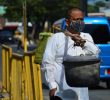As the city announced a shift in the way the annual Kadayawan Festival is celebrated — that is, for one, showcasing Lumad culture and tradition not for tourism’s sake — tribal leaders remain concerned that the festivities hardly depict the struggle of Mindanao’s indigenous peoples to pursue their unique way of life and retain control of their ancestral lands, which have been encroached into by big mining companies and plantations.
By Tyrone A. Velez
and Cheryll D. Fiel
Davao Today
DAVAO CITY, Philippines — Every August during the past 22 years, Davao City celebrates the region’s indigenous peoples, or Lumads. And for years, Lumads have complained of the commercialization, even bastardization, of their culture and traditions during the yearly Kadayawan. As Mayor Rodrigo Duterte himself admitted during the opening of the festivities last week, the Kadayawan had been primarily to entertain tourists and that its primary purpose — to extol and showcase the Lumad — had been set aside in favor of tourism.
This year, the mayor promised a different Kadayawan, a celebration that would go back to its true objective.
In a message read by his daughter, Vice Mayor Sara Duterte, during the opening ceremonies on Aug. 8, Duterte lamented that Kadayawan had, in recent years, somehow �lost track of its indigenous beginnings and has turned commericial and too tourist-oriented.�
�In the eagerness of pleasing foreign and local tourists, the Kadayawan celebrations churned out events that have marginalized and even offended indigenous communities,” the mayor said. This was due, in part, to the effort by organizers to give the festival a “modern twist,” referring, for instance, to the often incongrous choreographies of the street dancing that are more like the carnival in Rio de Janeiro.
“We have contributed to the bastardizations of our cultural ritual and traditions,� Duterte said.
While tourism is important, Duterte said, it is not the whole point of the celebration, whose essence should be to pay tribute to the Lumads who, in his words, �beat the hardest stone� and were the �first to cultivate and took care� of Davao. The region is home to several Lumad tribes, many of them trying to keep intact their way of life in the hinterlands.
This year, Duterte added, “we are going inwards and celebrating our inner strength as a people. We are going back to our authentic self which is rooted to our tribal ancestry.� The mayor said the theme of this year’s celebrations — �Lumadnong Kagikan, Mabungahong Kinaiyahan, Gasa sa Kahitas-an� (�Indigenous Heritage, Abundant Nature, God’s blessings�) — reflect this shift in how the festival is celebrated.
The Kadayawan’s highlight is the �Indak-indak sa Dalan� (Dancing in the Street) where participants coming from different regions in Mindanao perform tribal dances in colorful costumes and to the frenzied beat of tribal instruments.
But this year, the city has allotted the Rizal Park for use of the eight Lumad tribes — the Tagabawas, Ovu-Manuvu, Kalagan, Tausug, Sama, Maguindanao, Maranao and Ata — where, from 8 a.m. to 5 p.m., they can share with the public their traditional dances, music and songs.
Another change is the Hiyas ng Kadayawan beauty pageant. Beginning this year, it will only have contestants from the tribes. Each tribe will choose its own representative.
To be sure, Davao is not the only one that holds annual festivals featuring tribal presentations. According to the National Commission for Culture and the Arts, there are 13 such festivals in Mindanao.
Rarely, however, do these presentations — while showing colorfully the Lumad culture and heritage — depict the facet of Lumad existence that is rooted in strugglle, often violent, to retain their land and their identity. By presenting the Lumad as mere tribal entertainers, the Kadayawan does them injustice, according to Lumad leaders interviewed by davaotoday.com.
There are 18 Lumad tribes in Mindanao, namely Ata Manobo, Bagobo, Banwaon, B’laan, Bukidnon, Dibabawon, Higaonon, Mamanwa, Mandaya, Mangguwangan, Manobo, Mansaka, Matigsalog, Subanen, Tagakaolo, T’boli, Teduray at Ubo. Their population is already dwindling — as of last count by the government in 1994, they number only 2.9 million.
These Lumads face constant threats of being driven from their land due to �development�, according to Monico Cayog, a 72-year-old Bagobo leader whose tribe reside in Davao del Sur province.
According to Cayog, companies engaged in large-scale mining, plantations, logging and hydroelectric power are encroaching into their ancestral land.
In his province for instance, a hydro-electric power plant by the Aboitiz is being developed that will utilize the Tudaya Falls in Sta. Cruz town. For the Bagobos, Tudaya is a sacred ground. Cayog visited the place during a ritual last year, and already the local tribe was troubled by the entry of the plant.
Indigenous Peoples









